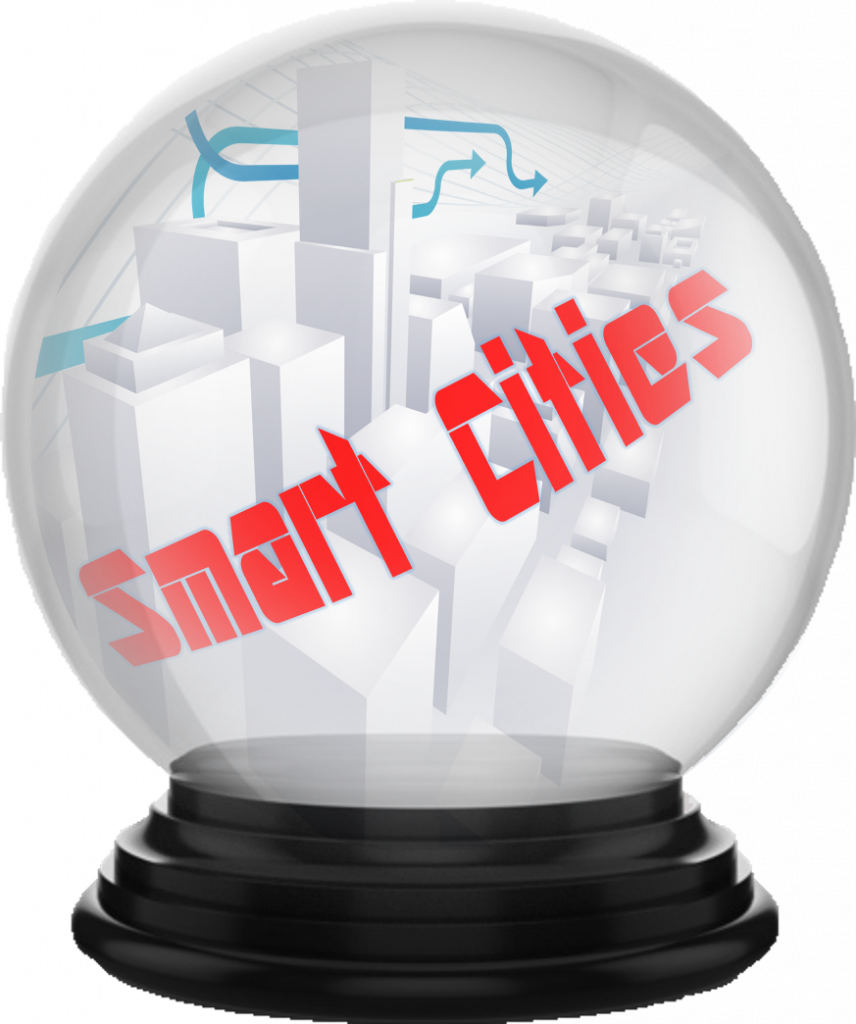Most of the pieces necessary to make cities smart are now available. A few cities, like Barcelona, have taken advantage of these technologies and deserve “smart city” recognition. Other cities are struggling to find the funds necessary to implement smart city solutions. Matthew James Bailey, a smart city advisor, notes, “The drive for smarter cities is growing exponentially as municipalities tackle critical challenges in areas such as public and environmental health, safety and security, mobility and more.”[1] Becoming a smart city is not just about being technologically-advanced — although technology plays a large role. Cities want to become smarter about how to use their resources and improve the lives of people. IBM believes “people” are one of six core systems smart cities must optimize and integrate. The other five systems are: business; transport; communication; water; and energy. I would add a seventh system — waste management (which includes both trash and sanitation). Hrvoje Cindric, an associate at ARUP, explains, “The promise of smart cities of the future is enormous — congestion, pollution, overcrowded transit, wasted energy, delayed emergency response all problems of the past.”[2] He adds, “[With] the digitization of analogue processes, big data, the internet of things, automation, machine learning, neural nets, artificial intelligence — almost anything seems to be within the realm of possibility. Smart city decision makers will have access to oodles of data to base their decisions on, and better yet decision-making will be made even easier as all options will be presented having been thoroughly analyzed by sophisticated systems.” Below are a few trends and predictions offered by smart city experts.
Smart city trends
Trend 1. Citizens are concerned smart cities will become big brother. Smart cities only become smart when they collect and analyze data. People are concerned how that data will be used. Data ownership is another issue. Cailin Crowe writes, “As cities increase their abilities to use and target data, concerns and demands for data protection will surely grow.”[3] Bailey adds, “Data ownership will become more prominent in local and global discussions as new approaches are explored regarding citizens owning their data.”
Trend 2. Traffic congestion tops smart cities agenda. Cities have always wrestled with how best to move people around efficiently and affordably. Traditional transportation systems like trams, subways, buses, and taxis are facing new competition by services such as Uber and Lyft and other micro-mobility platforms (i.e., scooters and bicycles). Those services have been widely popular, but cities have discovered ridesharing services add to rather than relieve inner-city congestion. Rather than risk being banned from cities, companies like Uber are trying to figure out ways to take traffic of the street and move it into the air. Crowe reports, “The new year will likely be momentous for investments in electric vertical take-off and landing aircrafts (eVTOL), or ‘flying cars.’ Uber pledged to start testing its Uber Air flying taxi service in 2020, and even projected eVTOLs will be mainstream as soon as 2023.” Cities are also trending toward car-free city centers and usage fees to drive within cities that increase during traditional traffic congestion timeframes.
Trend 3. Cities will continue to struggle with micro-mobility systems. Over the past few years, city streets have seen a rise in number of micro-mobility options available to residents. Dominique Bonte, smart cities and smart spaces vice president at ABI Research, states, “The adoption of micro-mobility in the form of electric bike, scooter, and motorcycle sharing significantly reduces both air pollution and traffic congestion — arguably the two biggest issues cities are grappling with today.”[4] They also increase sidewalk clutter and visits to the emergency room. Many cities are having second thoughts about micro-mobility solutions. As a result, Crowe reports, “Cities will see fewer scooter operators on streets as companies consolidate.”
Trend 4. Cities lead the fight against climate change. With the Trump administration abandoning most efforts to fight climate change, many cities have shouldered the burden. Bloomberg Associates Principal Adam Freed told Crowe, “People [are] recognizing as we near 2030 and 2040 and looking out at our climate goals, we can’t be building infrastructure that locks us into fossil fuel use for the next 20 to 30 years. You’ll see more efforts on the new build, which is easier to simply say ‘no hook ups.’ That’s going to help galvanize and accelerate the market for cost-effective technologies for electrification for heat and hot water and you’ll start to see retrofits come in and new developments that start to use those as well.” Bailey adds, “More renewable energy will be generated locally, boosting resilience, improving the local environment and enabling cities to explore new revenue models. Electric vehicle (EV) charging stations will become widespread and more common at petrol and gas stations and malls, stimulating the uptake of EVs.”
Trend 5. Cities fight back against cyber-attacks. Smart cities are connected cities. They rely on the Internet of Things (IoT) and other forms of connectivity to serve residents and run their processes. Recently, cities have been targets of ransomware and other types of cyber-attacks. Crowe reports, “In an effort to get ahead of the problem, a bipartisan bill was introduced in April 2019 to establish a grant program with the Department of Homeland Security that would help states develop cyber resilience measures. … And in July, over 225 mayors agreed to a U.S. Conference of Mayors resolution not to pay ransom in an effort to disincentivize hackers from targeting cities. Similar crackdowns and efforts to deal with the growing problem will continue to take precedence in 2020.”
Smart city predictions
Prediction 1. 5G for Everyone. Experts from Linchpin SEO predict, “Year 2020 is not just a new year but the signal of a new decade. The concept of 5G is slated to dominate this year with the biggest names in telecomm like Verizon, Nokia, Ericsson, AT&T, and more making sure that their 5G offerings stay on point. In the same token, Android’s handset makers will hit the ground hard and running with their 5G offerings in 2020. Because of faster speeds and more reliable connection, smart cities will reap its benefits by being able to offer smarter vehicles, smart processing and manufacturing, and more because they rely on this technology, too. Phones will not just be improved, but just about anything that impacts a human being’s daily life shall be affected positively by the onset of 5G.”[5] IDC predicts, “By 2024, one-third of all Smart Cities use cases will be impacted by 5G, and 75% of large cities will use 5G to scale key services such as real-time crime centers, V2I connectivity, and smart stadiums.”[6] Watch for continued struggles between city governments and the federal government over who controls 5G implementation.
Prediction 2. Cities will struggle with IoT implementation. The Internet of Things is the nervous system of a smart city; yet, many cities are struggling with IoT projects. Veronica Combs (@vmcombs) reports, “IDC [predicts], ‘In 2020, 10% to 30% of IoT will fail to launch or scale due to weak performance metrics, poor understanding of products, and lack of funding. … In a survey, city leaders said IoT projects stalled or died because of lack of internal skills, limited budgets, and a lack of understanding of the technology’s benefits.”[7] Experts from Smartcity Press are more sanguine in their predictions. They predict, “Internet of things is constantly expanding and will continue to do so in 2020. The deployment of 5G networks will dramatically accelerate the use of connected IoT devices with over 20 billion already predicted. In the approaching year, most of the sectors will integrate IoT into their new techniques and strategies.”[8] Until cities master IoT implementation, they will falter in other smart city efforts.
Prediction 3. System of systems approach will gain favor. Most smart cities experts insist a system of systems approach is what really makes a city smart. Using digital twin technology helps foster this approach. IDC predicts, “By 2023, 25% of successful Smart Cities digital twin platforms will be used to automate processes for increasingly complex, interconnected ecosystems of assets and products.” Bailey adds, “Digital twins will provide a pathway to ‘digital citizens’ – digital intelligences based on artificial intelligence (AI) technologies and tasked to deliver the next generation of individual and community digital services and experiences.”
Prediction 4. Smart city use of artificial intelligence will increase. Smartcity Press experts predict, “Smart cities will explore better opportunities for training AI into becoming a self-learning system.” Linchpin experts add, “Modern data analytical tools are necessary to stay on top of the game. They help in identifying problems, zeroing in on opportunities, and finding solutions. The processing of real time data shall be one of the main points of digital transformation in smart cities this 2020. … Machine learning and AI have gotten better at analysis and they can also be scaled while they are in their cloud storage. In terms of convenience, these machines are also a lot more easy to use and definitely a lot more reliable than the older methods of yore. As good as these machines are performing the past few years, they are slated to improve by leaps and bound this 2020.”
Trend 5. Cities will have to come to terms with autonomous vehicles. Linchpin experts predict, “The new reality will be connected vehicles and autonomous drones in smarter cities. These autonomous cars are being slowly introduced and they will certainly gain traction this 2020.” Bailey adds, “Self-driving trucks and other forms of autonomous transport will start to become widely accepted by society and government. The connected car may become successful before the self-driving car in order to enable existing vehicles, both old and new, to operate within a common transportation, mobility and safety framework. Cities will trial new forms of business models for vehicles, such as paying for fast-moving lanes.”
Concluding thoughts
Cindric concludes, “We humans have 6,000 years of experience in making cities, and we must build on this. Modern city-making professions have their origins in mass urbanization that the north-Atlantic world experienced during the first industrial revolution and the resulting squalor of cities in the 19th century. Modern architecture, public health professions, etc. all stem from a desire to improve the cities for its residents. The last 100 or so years we have sought salvation in designing cities for the car. Now we are turning to another technology [AI] to help us resolve the problems it caused.” Only a holistic approach will result in truly smart cities and a better world.
Footnotes
[1] Matthew James Bailey, “Towards the smart cities of 2025,” Smart Cities World, 31 December 2019.
[2] Hrvoje Cindric, “The promise and possibilities of smart cities,” Gulf News, 12 January 2020.
[3] Cailin Crowe, “7 trends that will define smart cities in 2020,” Smart Cities Dive, 2 January 2020.
[4] Sue Weekes, “Five ‘holistic’ tech trends set to shape smart cities in 2020,” Smart Cities World, 23 December 2019.
[5] Team Linchpin, “Trends That Will Transform And Shape Smart Cities In 2020,” Linchpin SEO, 26 December 2019.
[6] Veronica Combs, “10 predictions for smart city priorities in 2020,” TechRepublic, 20 December 2019.
[7] Ibid.
[8] Staff, “A Glimpse Into The Near Future – Smart City Predictions for 2020,” Smartcity Press, 17 December 2019.





